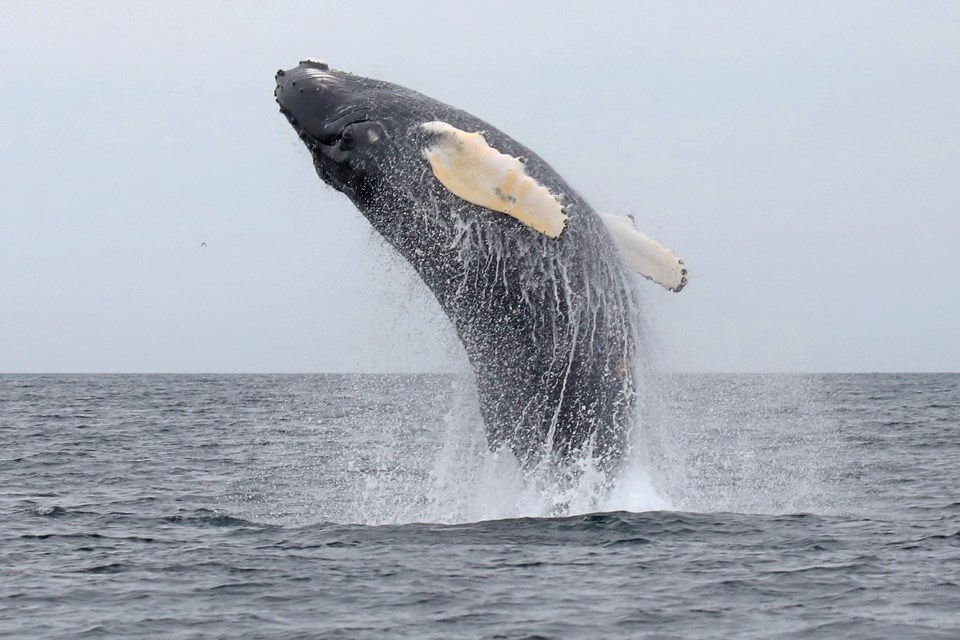The following is a first-person account by Village Media freelance photojournalist Kevin Lamb following a whale-watching excursion to Newfoundland.
A foggy day greets us, gulls call in the distance unseen through the mist, and a humpback whale exhales loudly next to our rubber Zodiac.
It inhales, arches its back gracefully and submerges slowly below the surface finishing with its tail rising into the air that then quietly disappears below the surface with hardly a ripple left behind on the quiet morning water.
We had been slowly following this whale at a respectful distance for about half an hour before finding ourselves out of the fog and within a gathering of three other humpbacks playing at the surface, their flukes waving in the air, which are their long side fins that are part of the unmistakable features of these gentle goliaths.
Before long they are all thrashing around causing an incomprehensible amount of water to boil up at the surface just before they flick their tails with a couple of powerful pumps and disappear again.
Without warning about 50 yards away there is an explosion of water as one of the behemoths breach almost completely out of the water and crashes back down displacing a huge amount of water as its 35 tons re-enters its world beneath the waves.
And with that dramatic moment the childhood dream of a 48-year-old had been long realized.
The whales would go on and jump 11 more times in the next 30 minutes or so, including a couple of heartfelt attempts by a young humpback whale calf.
This was our ninth day on the water off the coast of eastern Newfoundland and our umpteenth close-up interaction with a humpback whale. There have been just too many of them to count up to this point.
Our home base was the gorgeous seaside tourist community of Trinity, NL, a town with as much fascinating history as there are whales that make the annual pilgrimage north from the warmer southern waters.
Humpback whales will spend about six to eight weeks here before they begin the journey south and will not eat again until they return to Newfoundland at the same time next summer.
Their only purpose for the long trip is to feast upon countless billions of small fish called capelin.
This eight-inch slender fish is the valuable food of many animal species in the area consisting mainly of bald eagles, puffins, cod, dolphins, minke whales, sperm whales, and the second largest whale on Earth, the fin whale, which checks in at a length of up to 78 feet. And there were plenty of fin whales to behold.
Skipper Bob, owner and operator of Trinity Eco-Tours, deftly maneuvered the vessel to keep us within sight of the whales. His ability to spot the far away and faint water spouts from the whales is uncanny, although after a week of trying ourselves, it becomes much easier when you know what to look for.
We spent 10 days with Skipper Bob at his bed-and-breakfast home that was originally built in the 1840s. The original hardwood floors clearly worn with many generations of foot traffic and the house was a perfect and peaceful place to lay our heads at the end of a day out on the water.
The town of Trinity is tucked away inside one of the best natural harbours in the world.
The fort at the mouth of the cove, which no longer stands guard, was home to the British Royal Navy dating back to 1748, but was briefly interrupted a few times with French occupations in the 1700s.
The original cannons still point seaward and stand as a distant memory of conflicts past.
One notable resident, John Clinch, was the first to introduce the smallpox vaccine into North America in 1798. Clinch wore many hats while in Trinity, serving as judge, pastor and doctor to the people of the area.
As far as the arts go, Trinity was home to the filming location of the CBC’s series Random Passage, which is open to the public, as well as the Hollywood film The Shipping News.
Being Newfoundland, fishing has always been the mainstay of the region and Trinity has been a hub for fleets off-and-on since the 16th century.
Gaspar Corte-Real, a Portuguese explorer, named the spot Trinity after arriving there on the Christian day of Trinity Sunday, in 1501.
And if exploring on your own is what you are after there are many trails surrounding the town and tall cliffs looking out over the Atlantic Ocean.
The stunning and abundant wildlife is what will surely bring us back to Trinity, as well as the kind and generous people of Newfoundland, making this province our favourite place to visit time after time.
And it will one day be called home.
